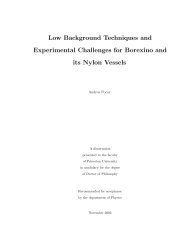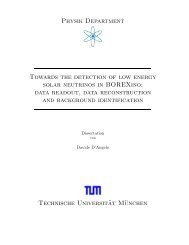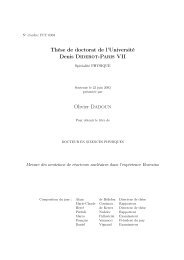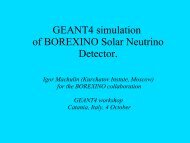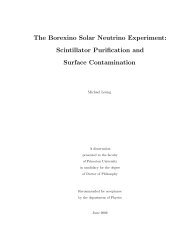Development of a Liquid Scintillator and of Data ... - Borexino - Infn
Development of a Liquid Scintillator and of Data ... - Borexino - Infn
Development of a Liquid Scintillator and of Data ... - Borexino - Infn
Create successful ePaper yourself
Turn your PDF publications into a flip-book with our unique Google optimized e-Paper software.
1 Solar Neutrinos<br />
Figure 1.1: The pp-cycle is the dominant energy generation mechanism in the sun. It is subdivided<br />
into four chains: pp-I 85 %, pp-II 14 %, pp-III 0.016 %, pp-IV . The reactions, in<br />
which neutrinos are emitted, are framed.<br />
(2) The sun is in hydrostatic <strong>and</strong> thermal equilibrium. This means that the hydrostatic pressure<br />
resulting from thermonuclear fusion counterbalances the gravity, <strong>and</strong> that the energy produced<br />
by nuclear reactions balances the total energy loss, which is the sum <strong>of</strong> the radiative<br />
energy flux (luminosity) <strong>and</strong> the energy carried away by neutrinos.<br />
(3) Energy transport from the solar center, where nuclear fusion takes place (Ö Ê¬),<br />
outwards to the surface occurs, apart from neutrinos, primarily by electromagnetic radiation<br />
<strong>and</strong>, for Ö Ê¬, additionally by convection.<br />
(4) Initially, the chemical composition <strong>of</strong> the sun was homogeneous. The local abundances<br />
<strong>of</strong> individual isotopes in the solar interior have slowly changed with time due to nuclear fusion,<br />
while in the surface layers the initial elemental abundances are preserved.<br />
The boundary conditions for the model are the sun’s known characteristics: the solar radius,<br />
mass, surface temperature, luminosity <strong>and</strong> age. Other measured input data are nuclear reaction<br />
cross sections, radiative opacities <strong>and</strong> isotopic abundances.<br />
The system <strong>of</strong> differential equations for the solar structure <strong>and</strong> evolution is solved numerically.<br />
It yields, among other things, predictions for the solar core temperature Ì , the temperature<br />
<strong>and</strong> density pr<strong>of</strong>ile inside the sun, <strong>and</strong> the rates at which the various nuclear fusion reactions<br />
contribute to the He generation, hence the solar neutrino spectrum <strong>and</strong> flux. The solar neutrino<br />
spectrum according to the SSM [Bah98] is shown in fig. 1.2 <strong>and</strong> the expected neutrino fluxes<br />
on earth for the individual neutrino branches are listed in table 1.1.<br />
2



